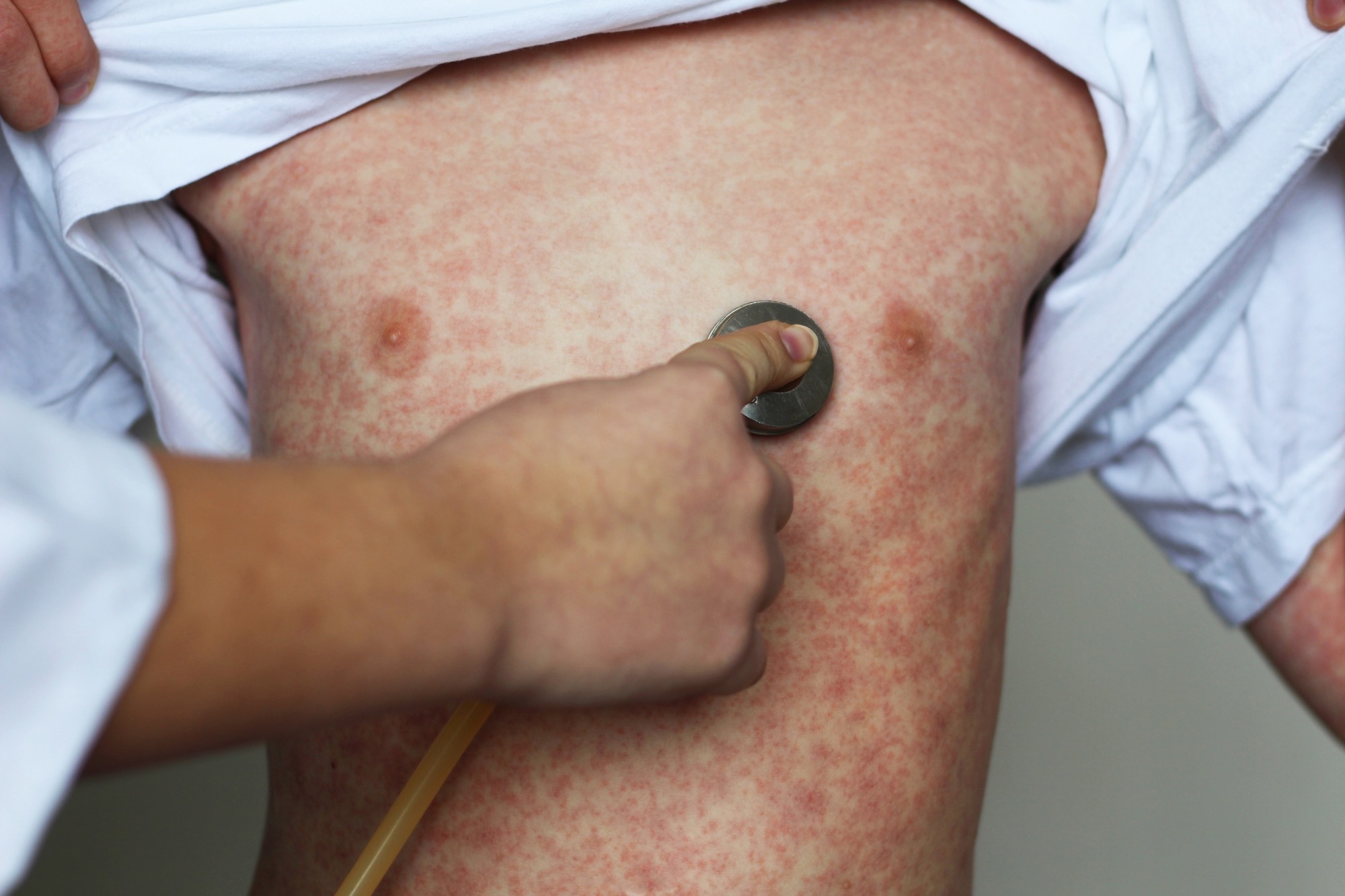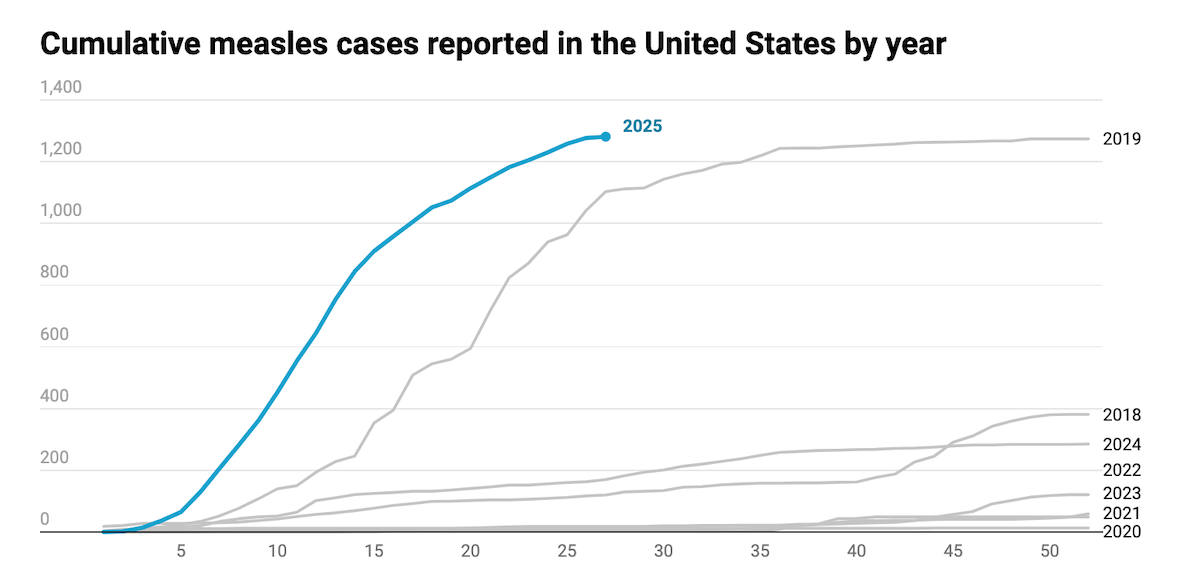The measles outbreak surge in 2025 in the US has been at a record high since its elimination in 2005. As of September 2, 2025, the CDC reported 1,431 confirmed measles cases in the United States, and with the end of the year still looming, this number can only be estimated to rise.
 Image credit: fotohay/Shutterstock.com
Image credit: fotohay/Shutterstock.com
Introduction: History of Measles / Pre-vaccination Era
Measles is known to be one of the most contagious diseases affecting humans; as an ancient disease, it was described as early as the ninth century by a Persian scholar and physician, named Abu Muhammed Zakariyyā Rāzī. The virus became more widespread in Europe and the Americas following global exploration in the 16th century.1
In 1757, a Scottish doctor called Francis Home found that a pathogen caused measles; he carried out an experiment where he transmitted the disease to healthy individuals using the blood of infected patients, thus demonstrating that an infectious agent caused measles.1
In the pre-vaccination era, measles was part of a global endemic and remains a worldwide epidemic disease. By the mid-20th century, improved nutrition and healthcare in high-income countries reduced measles mortality, but the global burden remained extremely high. Before widespread vaccination in the 1980s, millions of children still died of measles each year worldwide.1
Vaccine Development and Elimination in the U.S.
The measles vaccine was developed from the ‘Edmonston-B’ strain by John Franklin Enders, nicknamed ‘the father of modern vaccines.’ After testing their measles vaccine on small groups of children in 1958–1960, Enders and his team began trials on thousands of children in New York City, U.S., and Nigeria. This vaccine was deemed to be 100% effective in 1961 and was licensed for public use in 1963.2
From the 1960s and onwards, mass vaccination programs against measles were rolled out in individual countries at the national level, with the first international measles immunization program taking place in Africa from 1966.2
The measles, mumps, and rubella (MMR) vaccine was developed by Hilleman in 1971, combining the vaccines of all three pathogens into a single shot, which requires a booster dose. In 2005, the U.S. licensed the MMRV vaccine, a four-in-one formulation that added varicella (chickenpox) protection to the existing MMR schedule.2
The World Health Organization (WHO) recommends using this vaccination in babies aged nine months in regions with common measles, and at 12–15 months for areas with less common occurrence.1 Measles was declared to be eliminated from the U.S. in 2000, meaning no measles cases were found to be spreading within the country. New cases were only seen when someone contracted the disease abroad before returning to the country.3
Current Surge: Worst Measles Year Since Elimination
There were 35 measles outbreaks in 2025, reported by the Centers for Disease Control and Prevention (CDC). As of September 2, 2025, 1,431 measles cases have been confirmed in the U.S. Of these cases, 12% were hospitalized, with three cases resulting in death. A total of 18 measles cases were reported among international visitors who were traveling to the U.S.3
The measles outbreak of 2025 represents a sharp increase compared with 2024, when the U.S. recorded 285 cases and 16 outbreaks by December 31, including 16 cases linked to international visitors.3
At this rate of reported measles cases, the U.S. has surpassed a milestone, with 2025 having the most cases since the declaration of measles’ elimination in 2000, and the highest number of cases in over three decades.4

Figure 1: Total and recent number of reported measles cases at the county level. Data available from Johns Hopkins School of Bloomberg of Public Health 4
Reasons for Vaccine Coverage Decline
A new report by the CDC demonstrated that childhood vaccination in the U.S. continues to decrease, with vaccination exemptions at an all-time high. During the 2024-25 school year, the coverage for the MMRV vaccine decreased among kindergarten children. MMR vaccine coverage was approximately 92.5%, below the 95% threshold required to prevent measles transmission.4
Interestingly, state-level coverage for MMR vaccines varies, with rates ranging from 78.5% in Idaho to 98.2% in Connecticut. Only 10 U.S. states had a coverage of 95%.4
This immunization gap has led to measles outbreaks in many U.S. states and may be the reason behind the highest surge in measles cases in 2025, since the disease was declared eliminated.4
Public Health Responses
The ongoing outbreak we are seeing in the U.S. underscores the importance of maintaining adequate levels of measles vaccination. The U.S. is at risk of losing its measles elimination status should cases continue at this rate. As vaccine confidence continues to be undermined, immunization is more important than ever to end this outbreak and prevent future outbreaks from occurring.4
International Vaccine Access Center (IVAC) Executive Director, William Moss, from the Bloomberg School of Public Health
With the highest surge of measles cases, public health focus aims to be on strengthening public trust in the safety and efficacy of vaccines, to reverse the decline in childhood immunization rates in the U.S.5
Long-Term Risks and Projections
A great concern regarding vaccines includes parents who are choosing not to vaccinate their children for non-medical reasons; if this trend continues, the rise in disease outbreaks will also follow.5
With 97% of cases in 2025 being reported as being unvaccinated or to have an unknown vaccination status, long-term risks for this group remain a major concern.6
Additionally, with the outbreak spreading into Mexico, additional cross-border public health concerns are also raised, with broader implications for disease resurgence, reinforcing the need for strengthening vaccination efforts and public health interventions.6
References
- Centers for Disease Control and Prevention. Epidemiology and Prevention of Vaccine-Preventable Diseases. 14th ed. Washington D.C.: Public Health Foundation; 2021. https://www.cdc.gov/vaccines/pubs/pinkbook/meas.html. Accessed September 7, 2025.
- History of Measles Vaccination. https://www.who.int/news-room/spotlight/history-of-vaccination/history-of-measles-vaccination. Accessed September 7, 2025.
- Measles Cases and Outbreaks. https://www.cdc.gov/measles/data-research/index.html. Accessed September 7, 2025.
- U.S. Measles Cases Hit Highest Level Since Declared Eliminated in 2000. International Vaccine Access Center. https://publichealth.jhu.edu/ivac/2025/us-measles-cases-hit-highest-level-since-declared-eliminated-in-2000. Published July 1, 2025. Accessed September 7, 2025.
- Across the U.S. Childhood Vaccination Rates Continue to Decline. International Vaccine Access Center. https://publichealth.jhu.edu/ivac/2025/across-the-us-childhood-vaccination-rates-continue-to-decline. Published August 20, 2025. Accessed September 7, 2025.
- Kuppalli K, Omer SB. Measles: The Urgent Need for Global Immunisation and Preparedness. The Lancet. 2025;405(10489):1565-1567. doi:10.1016/s0140-6736(25)00675-0
Last Updated: Sep 9, 2025